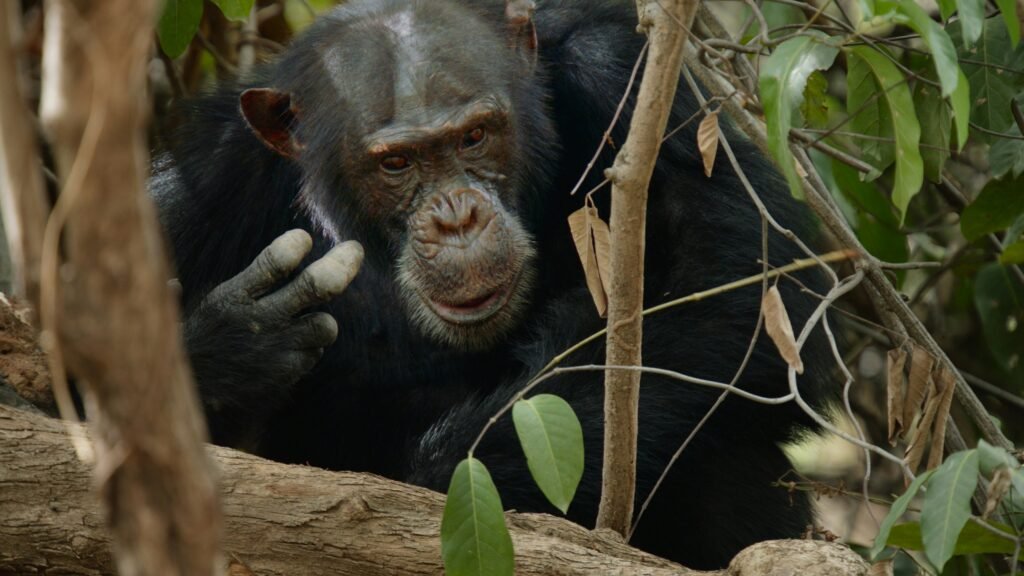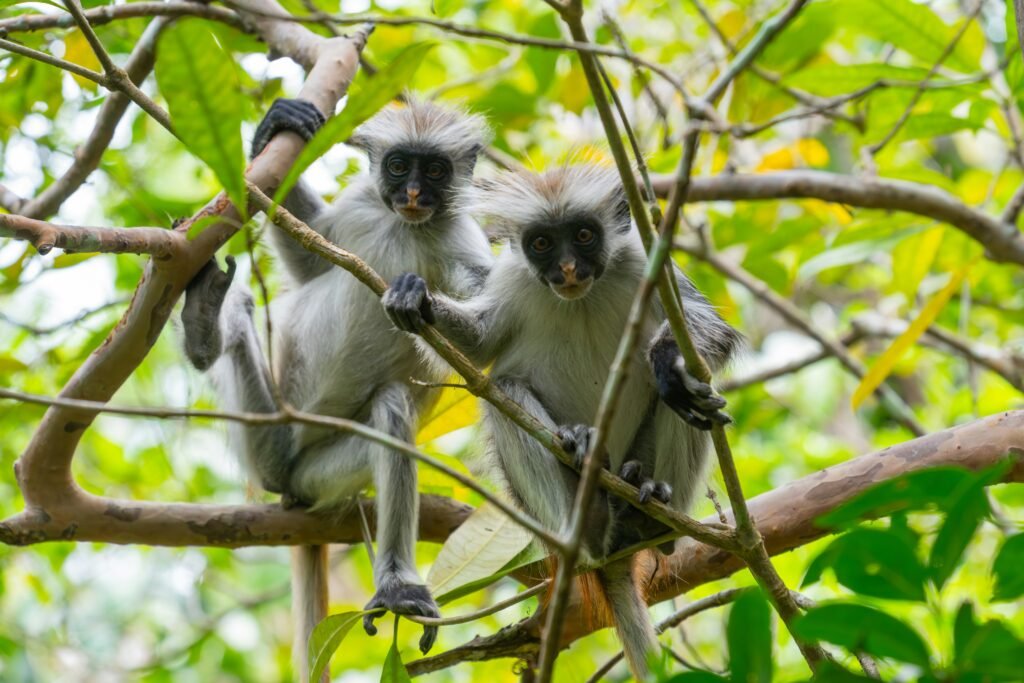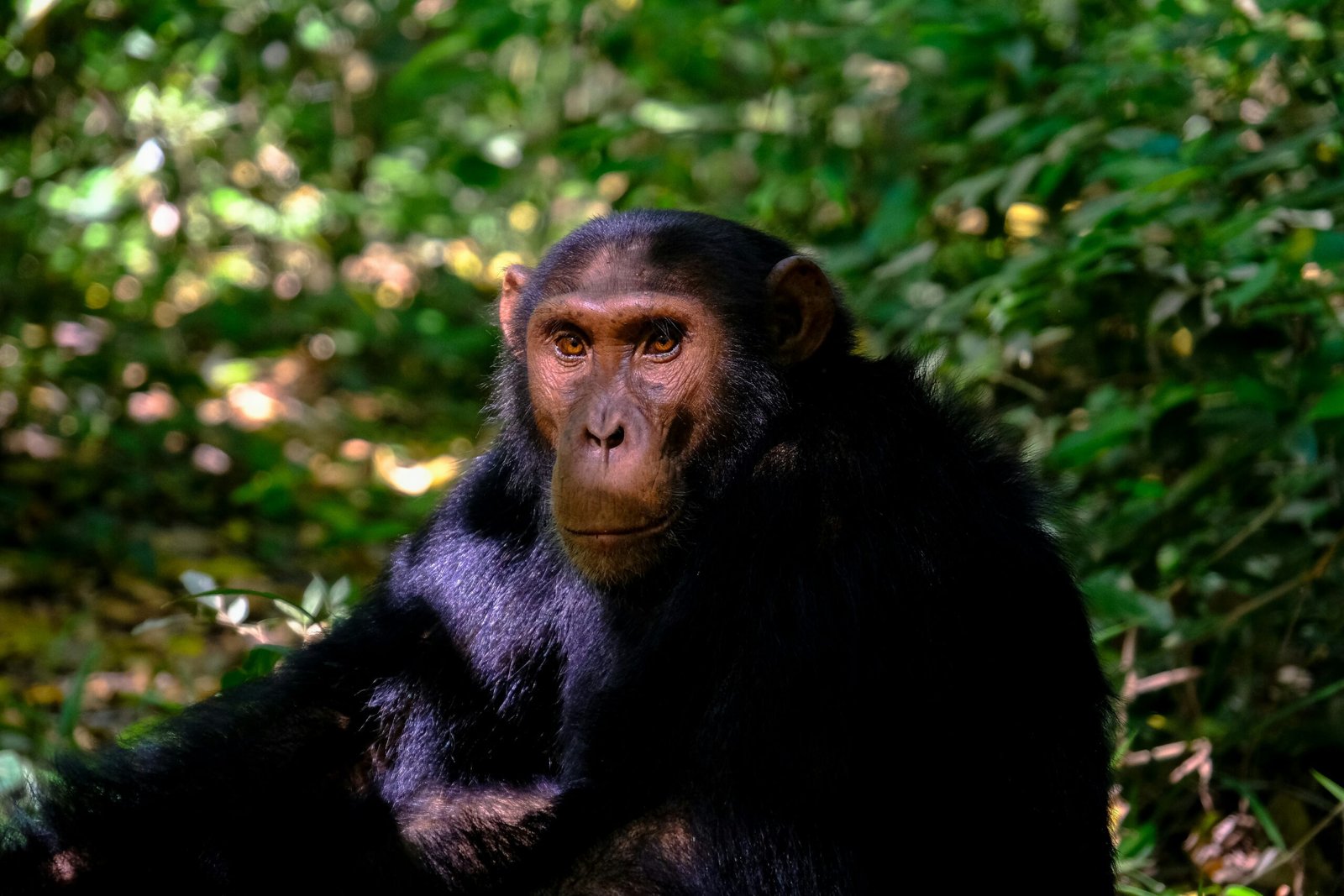Table of Contents
Tanzania’s appeal as a safari destination is undeniable, with its famous Big Five animals and sprawling savannahs. But for those willing to venture deeper, Tanzania offers a lesser-known, yet equally mesmerizing attraction: primate tracking. In this guide, we’ll explore where to find two of the country’s most sought-after primates, the chimpanzee and the colobus monkey. From trekking through dense forests to embracing the fascinating behaviours of these species, spotting these rare primates provides a new dimension to Tanzanian wildlife adventures.
“Tanzania isn’t just about the Big Five; it’s also one of East Africa’s best-kept secrets for primate lovers.”
1. Why Tanzania is a Prime Destination for Primate Viewing
When most people think of primate trekking, they imagine the mountain gorillas of Uganda or Rwanda. But Tanzania offers a unique opportunity for clients to observe primates in diverse, pristine habitats without the crowds that tend to congregate in other East African destinations. Tanzania’s chimpanzees and colobus monkeys can be found in breathtaking settings—like the Mahale Mountains or the lush Jozani Forest in Zanzibar—that allow travellers to experience a remote and immersive wildlife experience. With growing conservation efforts, Tanzania has preserved these habitats to ensure that primate tracking remains sustainable and accessible.
Highlights of Primate Experiences in Tanzania:
- Unique Species: Encounter chimpanzees and several colobus monkey species, including the rare Zanzibar red colobus.
- Diverse Landscapes: Traverse rainforests, mountain ranges, and coastal forests, each offering a unique viewing experience.
- Authentic Encounters: Small group sizes and secluded parks enhance the intimacy of the experience.
2. The Fascination with Primates: What Makes Chimpanzees and Colobus Monkeys Unique?
Chimpanzees and colobus monkeys are two of the most intriguing primates you can observe in Tanzania, each with unique behavioral traits and natural adaptations. For those interested in animal behaviors and primate intelligence, Tanzania’s primates offer a profound experience.
Chimpanzees

Chimpanzees are our closest living relatives, sharing about 98% of our DNA. Known for their complex social structures and highly developed cognitive abilities, chimpanzees use tools, communicate through vocalizations and gestures, and demonstrate behaviors that resemble human social interactions. These primates form tight social bonds and live in communities where each individual has a role, creating fascinating dynamics for observers to witness.
Interesting Behaviors of Chimpanzees:
- Tool Use: Chimps use sticks to extract termites from mounds, stones to crack nuts, and leaves to soak up water for drinking.
- Grooming: Grooming each other is both a hygiene practice and a way to bond socially.
- Communication: They use vocalizations, body language, and even facial expressions to convey emotions and messages.
Colobus Monkeys

The colobus monkey is distinctively beautiful, with striking black-and-white or red coloration and a lean, agile build. Colobus monkeys are one of the few primate species that primarily eat leaves, which makes their digestive system uniquely adapted. Unlike chimpanzees, colobus monkeys are generally quieter, relying on subtle calls and a diet that involves less foraging and more resting.
Unique Characteristics of Colobus Monkeys:
- Diet: Their diet mainly consists of leaves, giving them a unique, specialized digestive system.
- Social Groups: They live in small groups led by a dominant male, with females and juveniles forming the core of the group.
- Leaping Ability: Known for their incredible leaps between trees, colobus monkeys rely on their lightweight, flexible bodies to navigate the forest canopy.
3. Chimpanzee Tracking in Tanzania: Top Destinations
Chimpanzee tracking in Tanzania can be a demanding but immensely rewarding experience, requiring trekkers to traverse forested mountains, cross rivers, and navigate dense underbrush. The country is home to two primary locations for observing wild chimpanzees: Gombe Stream National Park and Mahale Mountains National Park.
Gombe Stream National Park
Gombe Stream National Park is legendary in the world of primate research. Established in the 1960s by Dr. Jane Goodall, the park’s chimpanzee population has been studied for decades, offering rich insights into their behaviours and lifestyle. Gombe is Tanzania’s smallest national park, accessible only by boat, which enhances its secluded, untouched feel.
What to Expect:
- Viewing Highlights: With luck, visitors can observe playful juveniles, dominant males displaying, and even mother-infant pairs.
- Landscape: Gombe features a mix of forested hills and valleys with streams that attract chimpanzees, providing excellent opportunities to see these animals’ close-up.
Mahale Mountains National Park
Mahale Mountains National Park is home to one of Africa’s largest populations of chimpanzees. Nestled along the eastern shores of Lake Tanganyika, the park’s remote location and striking scenery make it an unparalleled destination for chimpanzee tracking. Mahale’s chimpanzees are less accustomed to human presence, making sightings feel more authentic and wilder.
What to Expect:
- Primate Population: Mahale houses over 1,000 chimpanzees, which roam freely across the park.
- Landscape and Trekking: Mahale’s forested mountains require more physically demanding hikes, but the journey through lush forests with views of Lake Tanganyika is part of the experience.
- Best Time to Visit: Dry seasons from June to October and December to February offer clearer paths and better chances for tracking.
4. Spotting the Colobus Monkeys: Where to Go in Tanzania
Unlike chimpanzees, colobus monkeys tend to live in high forest canopies, where they spend much of their time resting, eating, and grooming. Tanzania boasts several habitats for colobus monkeys, each with unique environmental characteristics and experiences.
Jozani Forest (Zanzibar)
The Jozani Forest is the only national park in Zanzibar and the best place to see the rare Zanzibar red colobus monkey. This species is endemic to Zanzibar, making Jozani Forest the sole location where they can be seen in the wild.
What to Expect:
- Species and Sightings: The Zanzibar red colobus is known for its distinctive red fur and inquisitive nature, often seen in groups moving through the trees.
- Conservation Efforts: The forest is protected as a conservation area, and tourism directly contributes to these efforts.
Udzungwa Mountains National Park
The Udzungwa Mountains National Park offers a more adventurous primate-viewing experience. Home to several primate species, including the black-and-white colobus and red colobus, Udzungwa features trails that meander through rugged terrain, waterfalls, and tropical forests.
What to Expect:
- Variety of Primate Species: The park’s diverse ecosystem is ideal for seeing not only colobus monkeys but also other primate species like the Sanje mangabey.
- Landscape: Udzungwa’s mountains create a unique, dramatic landscape that attracts adventurous travellers.
5. Conservation Efforts and Sustainable Primate Tourism in Tanzania
Tanzania has made significant strides in conservation, with national parks and reserves that protect endangered primates and their habitats. Sustainable tourism plays a crucial role in these efforts, as the fees from permits and park entries help fund conservation projects and provide income for local communities.
Key Conservation Initiatives:
- Community Involvement: Many parks, such as Jozani, work closely with local communities to promote sustainable tourism and discourage poaching.
- Anti-Poaching Measures: National parks in Tanzania enforce strict anti-poaching laws and maintain rangers who monitor the areas for illegal activities.
- Research Programs: Continuous research on chimpanzee populations in Gombe and Mahale has contributed to understanding and protecting these primates.
By opting for a responsible tour operator, clients not only gain an authentic primate viewing experience but also help fund essential conservation work.
6. Planning Your Primate Safari
Packing Tips
Primate trekking often involves navigating rugged terrain, so packing accordingly can enhance comfort:
- Hiking Boots: Sturdy, waterproof hiking boots with ankle support are a must.
- Weather Protection: The rainforest environment means sudden rains, so a lightweight, packable rain jacket is essential.
- Binoculars and Cameras: To capture the details of primates in dense foliage, bring binoculars and a camera with a good zoom lens.
Fitness Requirements
While chimpanzee tracking can be physically demanding, colobus monkey viewing is generally less intense. Trekkers should be prepared for moderate hiking conditions, particularly in areas like Mahale and Udzungwa, where trails can be steep and forested.
Best Times to Visit
- Dry Season (June to October): Offers ideal conditions for trekking with fewer obstacles and easier paths.
- Green Season (November to March): While paths may be muddier, this is also a period when fewer tourists visit, allowing for more intimate primate encounters.
You can read more about Tanzania safari Seasons
7. Embrace a Unique Side of Tanzania’s Wildlife
Primate tracking in Tanzania is an amazing experience that brings visitors face-to-face with some of Africa’s most fascinating species. By stepping away from traditional safari activities and into the dense forests, clients can witness behaviours and interactions that are remarkably similar to our own, deepening our appreciation for the natural world. From supporting sustainable tourism to experiencing the intimate, wild beauty of Tanzania, tracking chimpanzees and colobus monkeys offers an unforgettable journey for anyone willing to explore the extraordinary.




